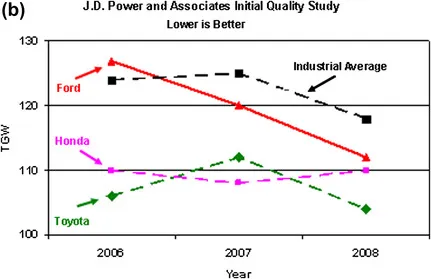1.1. Customer Expectation and Vehicle Quality
Vehicle noise may be roughly divided into two categories: the persistent type and the transient or come-and-go style. Persistent noise such as engine or road boom noise or wind noise will occur constantly during certain regular and wide-ranging operation conditions, and is often more annoying and discomforting to customers, and should be the first to be eliminated. With recent significant reductions in the persistent type of noise, the come-and-go kind of noise, including buzz, squeak and rattle (BSR), becomes more apparent and further needs to be eliminated to continuously improve vehicle quality [1], [2], [3], [4], [5], [6], [7], [8], [9], [10] and [11].
As discussed in reference 1, even as early as 1983 a market survey showed that squeak and rattle were already ranked the third highest customer concern for the three months in service (3MIS) period. In recent quality surveys, BSR was rated as the top quality issue including all original equipment manufacturers (OEMs – automobile makers) [2] and [3]. As Chance Parker, executive director of product and research analysis at JD Power and Associates, commented: “While the Initial Quality Study (IQS), which measures problems experienced in the first 90 days (3MIS) of ownership, can be an indicator of how models will perform over time, our studies consistently show that long term durability is a tremendously important factor to consumers. As the number of the problems owners experience with their vehicles increases, repurchase intent and the number of recommendations owners will make to others decreases.” The brands that perform better than the industry average vehicle dependability study (VDS) typically have $1000 more residual value than others that are below the average, according to JD Power and Associates [4] and [5]. VDS is surveyed every year for three-year-old models. An example is Ford, which made a significant improvement (on average, rectified nine faults) in its IQS from 2006 to 2008, as shown in Figure 1.1, which is modified to include most nameplates/brands and exclude luxury vehicles. Ford’s vehicle quality improvement in recent years has also been recognized by JD Power and Associates’ leading index and other leading vehicle quality research firms such as Consumer Reports, Strategic Vision, and Auto-Pacific. The 2008 JD Power and Associates’ Automotive Performance, Execution and Layout (APEAL) study showed that the Focus gained 88 index points over the last year. The Ford Escape also earned a spot among the top 10 most improved vehicles in the industry. In addition, five Ford Motor Company vehicles received second- or third-place honors in their segments. Strategic Vision put Ford neck-and-neck with Toyota for total quality, and ahead of everyone else. Ford has improved to 64% recommended vehicles from 54% in 2007 and 93% of Ford vehicles have average or better predicted reliability compared to last year’s 63% according to Consumer Reports. Part of Ford’s quality improvement is due to the reduction of BSR.
Prospective customers may first consult various quality reports including Consumer Reports and JD Power and Associates’ quality study, and decide which vehicle they may want to evaluate before buying. If there is an indication that some nameplate vehicle has a low quality ranking, it may not be even on the consideration lists of prospective customers. Every year JD Power and Associates will issue the rankings in their vehicle Initial Quality Study (IQS).
When a prospective customer test drives a vehicle, if there is a BSR the customer will perceive the vehicle as low quality. If this can go wrong, then something else might go wrong later. It will not only affect the customer’s decision to buy this vehicle but may also project a negative image for the nameplate, brand or even for the manufacturer. The same effect holds or is even worse when a customer finds a BSR after purchasing. Since it is a come-and-go type noise, it usually takes s...


